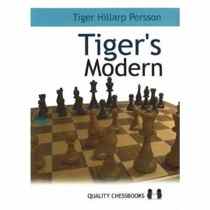Tiger’s Modern
Tiger Hillarp Persson

During my final year as an active tournament player, I began to experiment with non-mainstream openings. Why? Simply because my memory had become so poor that I was no longer capable of retaining the large quantities of analysis that main line systems demand. One “do it against everything repertoire I made use of was 1 d6 vs. anything White could possibly try on move one. Thus, against 1.d4 I would play 1 …d6 2.c4 e5 (since the endgame that results from 3.dxe5 dxe5 4.Qxd8+ Kxd8 is completely acceptable for Black), and against 1.e4 I would toss out 1 …d6, usually entering a Pirc Defense.
I was never completely happy with the classic way of playing the Pirc, so Tigers new book on his version of the Modern Defense would have been heaven sent. In Tigers Modern, the Swedish grandmaster offers up a complete repertoire based on 1 …g6 vs. anything. His main ideas are:
1.e4 g6 2.d4 Bg7 3.Nc3 d6 4.Be3 (or 4.f4 or 4.Nf3) 4 …a6!
This move is a very important part of his handling of the Modern, and Tiger jumps into it with amazing verve. In a clear but highly entertaining writing style, he gives us in-depth plans/rules/ideas that will prove invaluable to the reader. His fine explanations, mixed with a seemingly endless cascade of new plans and theoretical novelties makes the system extremely desirable all the more so when you realize that most opponents wont have the slightest idea how to deal with it!
Against 1.d4 g6 2.c4 Bg7 3.e4 (or 1.e4 g6 2.d4 Bg7 3.c4), Tiger recommends 3 …d6 4.Nc3 e5 as being well worth playing. He looks at 5.Nf3, of course, but he also explores 5…d5 f5 6.exf5 gxf5 7.Qh5+ Kf8, assuring the hysterical reader that the position is extremely promising for Black thanks to the tempo gain Nf6 followed by …Qd8-e8-g6. Other key positions that are addressed (after 4… e5): 5.dxe5 dxe5 6.Qxd8+ Kxd8 (fine for Black), 5.Nf3 Nc6 6.d5 Nce7 (complex and completely playable).
Tigers extremely dynamic ideas are not for the dogmatic! More often than not, youll see him shoving his g-pawn up the board with reckless abandon, or leaving a hole on f5 and laughing about it all the way to the bank. Nevertheless, its hard to ignore him since hes beaten some very strong players with this system, and the amount of hard work hes put into making these lines viable forces us to adorn his views with more than a little respect.
I feel players from 1600 to grandmaster can get a lot out of this book. Without a doubt, it will be a tough road for those under 2000 at first, but the authors plan-rich explanations (some of the best Ive ever seen!) make mastering this system doable.
Highly recommended!
